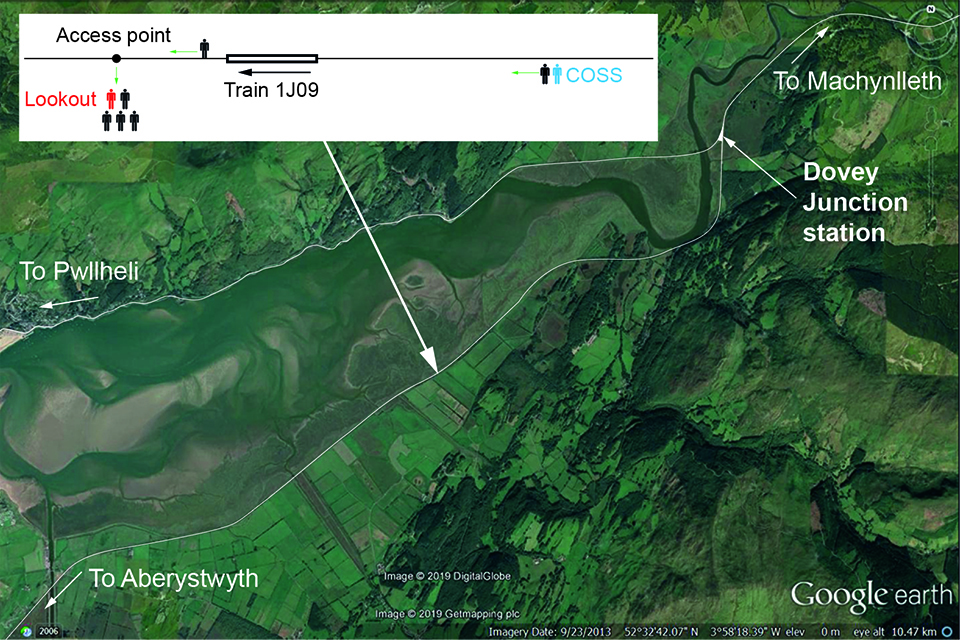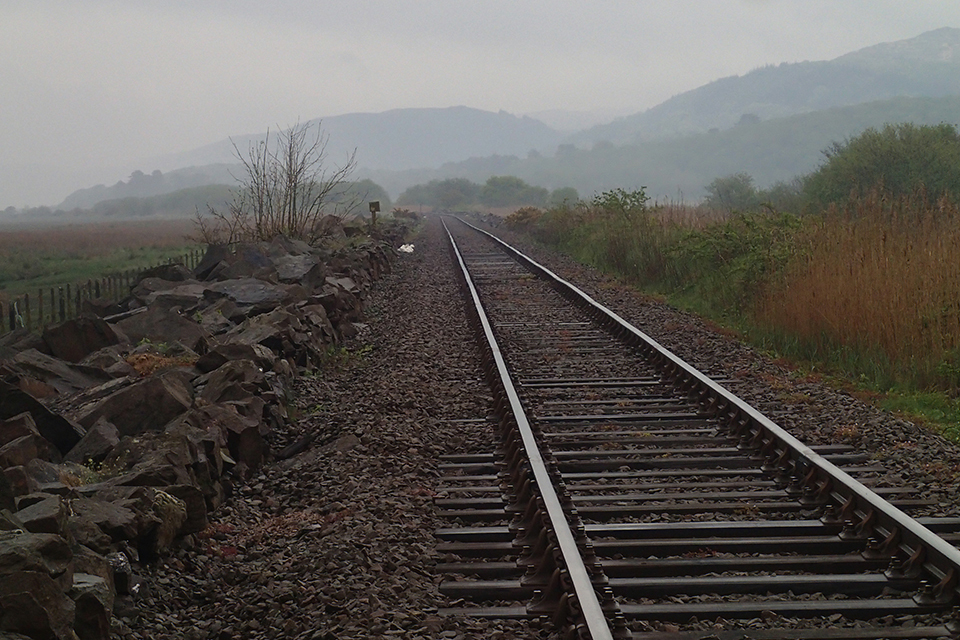Narrowly avoided collision between a train and a track worker at Ynys Hir, Ceredigion, 2 April 2019.
Published 29 July 2019
1. Important safety messages
This incident demonstrates the importance of:
- a COSS (Controller of Site Safety) and their work group keeping together, so that they can remain in contact with each other and the COSS can give them clear instructions, particularly once work is complete and when walking to and from the site of work
- lookouts remaining alert and carefully watching for approaching trains once work is complete
- drivers giving a series of short warnings on the train horn to alert anyone that has not acknowledged an initial warning or moved clear of their train
2. Summary of the incident
At 11:58 hrs, a track worker narrowly avoided being struck by a train at Ynys Hir, near Dovey Junction station. The track worker was one of a group of eight that had just completed fishplate oiling work on the single line that runs towards Aberystwyth. The work group became separated as they were walking back to an access point. The line was open to traffic and a lookout had been appointed to provide the group with a warning of approaching trains while working and walking on the railway.
The train involved was 1J09, the 10:29 hrs passenger service from Shrewsbury to Aberystwyth. It was travelling at close to line speed (95 km/h). The driver sounded the horn on sighting the first two members of the work group. They were already in a position of safety and acknowledged the warning. Around 10 seconds later, the driver observed another track worker walking in the four foot (between the two rails of the track) with his back to the train. The driver again sounded the train horn. The track worker did not hear the horn until the driver had also applied the emergency brake and the train was virtually upon him. He then immediately moved clear.
By this time, the other five members of the work group had reached the access point and were leaving the railway. No-one was injured, but the driver and some members of the work group were badly shaken.

Track layout showing the location of the incident, the direction of the train and the approximate position of the work group at the time of the incident

View of the track from the access point looking towards Dovey Junction station
3. Cause of the incident
The incident occurred because the work group became separated and the COSS could no longer ensure that the safe system of work functioned correctly.
The planned work at Ynys Hir was organised by Network Rail’s local maintenance depot at Machynlleth. A team leader and a track worker from the Network Rail depot were allocated, and six contract staff from Ganymede Solutions were hired to assist. The planner at the Machynlleth depot obtained approval to implement a safe system of work based on warnings from a single lookout. Network Rail’s team leader was appointed as the COSS responsible for managing the safe system of work. He was also the PIC (Person in Charge).
The eight person work group met at the access point near milepost 82 1⁄4 at around 08:45 hrs. The team leader checked the sighting of trains, briefed the work group and completed the work planning forms. He appointed one of the Ganymede Solutions’ staff to act as lookout. The work group then went onto the railway and started work, making its way towards Dovey Junction.
The work group stayed together during the work. Two trains approached: one from Aberystwyth at around 09:40 hrs, and one from Dovey Junction at around 11:00 hrs. The lookout warned the work group on both occasions and they moved to a position of safety. On completion of the work, the team leader told the work group to return to the access point.
The work group began to separate as they walked back towards the access point: the lookout and the five other Ganymede Solutions staff walking ahead of the Network Rail team leader and track worker. The group walked in the four foot because they found that the underfoot conditions were difficult in the cess.
At around 11:45 hrs the work group got off the track when the lookout warned them of a train travelling towards Dovey Junction. On returning to the track they started to separate further. The Network Rail team leader has stated that he tried to call to those ahead, but was unable to get their attention. The RAIB found evidence that, while the team leader was conscious that train 1J09 would be waiting in the passing loop at Dovey Junction station, the lookout was not expecting there to be another train for around 45 minutes and may not have been regularly looking back. The lookout recalled the team leader mentioning the periodicity of trains when he briefed the work group as part of his COSS duties. It is possible that the lookout’s expectation was based on incorrect conclusions he had drawn from this.
The Network Rail team leader and track worker had a good view of trains approaching from Dovey Junction station, and expecting to see train 1J09, started to look back regularly. This may have slowed them and allowed the Ganymede Solutions staff to get even further ahead. It was probably around that time that the track worker involved in the near miss stepped off the track to answer a mobile telephone call. After the call he continued walking along the track, now behind his five colleagues, but still ahead of the two Network Rail staff.
The Network Rail team leader sighted train 1J09 when it was distant. He and his colleague moved to a position of safety. By now, the Ganymede Solutions staff were reported to be around “150 yards” ahead. The team leader recalled shouting at them to get off the track. He also used his whistle, but he couldn’t make himself heard. The six Ganymede Solutions staff carried on walking, their backs to the approaching train.
The driver of train 1J09 saw the Network Rail team leader and track worker at 11:57:38 hrs and sounded two blasts on the train horn; they both raised their arms to acknowledge this. Around 10 seconds later the driver saw the track worker in the four foot. The driver again sounded two blasts on the horn, and immediately started to reduce traction power. The track worker did not hear the train horn. The lookout and the four other Ganymede Solutions staff then saw the train as they turned to leave the track at the access point. One of them, appreciating the imminent danger, shouted “one on” and the lookout made arm gestures for the track worker to move out of the way. The RAIB found no evidence to suggest that the lookout had seen train 1J09 before this.
The driver reacted to the lack of acknowledgement from the track worker by continuously sounding the train horn and applying the emergency brake. The track worker reported hearing the horn when the train was just a few feet away and immediately moved clear. Train 1J09 came to a stand close to the access point.
The Rule Book requires a COSS to stay with their work group while they are on the railway, so that they can observe and advise everyone. While no proximity criteria are defined, the wording of the Rule Book implies that the COSS should remain close enough to communicate clearly with the whole group. When relying on warnings from a lookout, the responsibilities of the COSS include positioning the lookout(s) so that any approaching train can be seen and adequate warnings are provided to the entire work group. The Rule Book requires lookouts to remain in position, stay alert and carefully watch for approaching trains.
The railway at Ynys Hir is exposed and follows a coastal estuary. It was reported to be windy at the time and local weather station records evidence that the Ganymede Solutions staff were directly upwind of both the Network Rail team leader and the approaching train when they were walking back towards the access point. This possibly explains why, having become separated, the team leader was unable to make himself heard by the work group. It also may explain why the track worker did not hear the horn of train 1J09 until late.
The Rule Book requires drivers to use the train horn to give a series of short urgent warnings when those on the railway do not immediately acknowledge or move clear. Although far from certain, it is possible that a series of short warnings, rather than continuous sounding of the train horn, might have resulted in the track worker becoming aware of train 1J09 earlier.
Network Rail’s process for controlling the risks from train movements to staff who are on the railway requires consideration of a hierarchy of control measures when planning the safe system of work. In this instance, other safe systems of work were considered to be impractical. While the process states that reliance on lookouts should be ‘regarded as the last resort’, Network Rail considered it to be suitable and safe given the good sighting available at Ynys Hir.
4. Previous similar occurrences
RAIB Bulletin B01/2012 describes an incident at North Kent East Junction on 2 February 2012. A three person work group, comprising a COSS, lookout and a supervisor, became distracted after work had been completed. The lookout was standing too close to the line, and a passing train hit a set of flags he was carrying, knocking him to the ground. The COSS had not remained vigilant with regard to the safe system of work following completion of the work.

